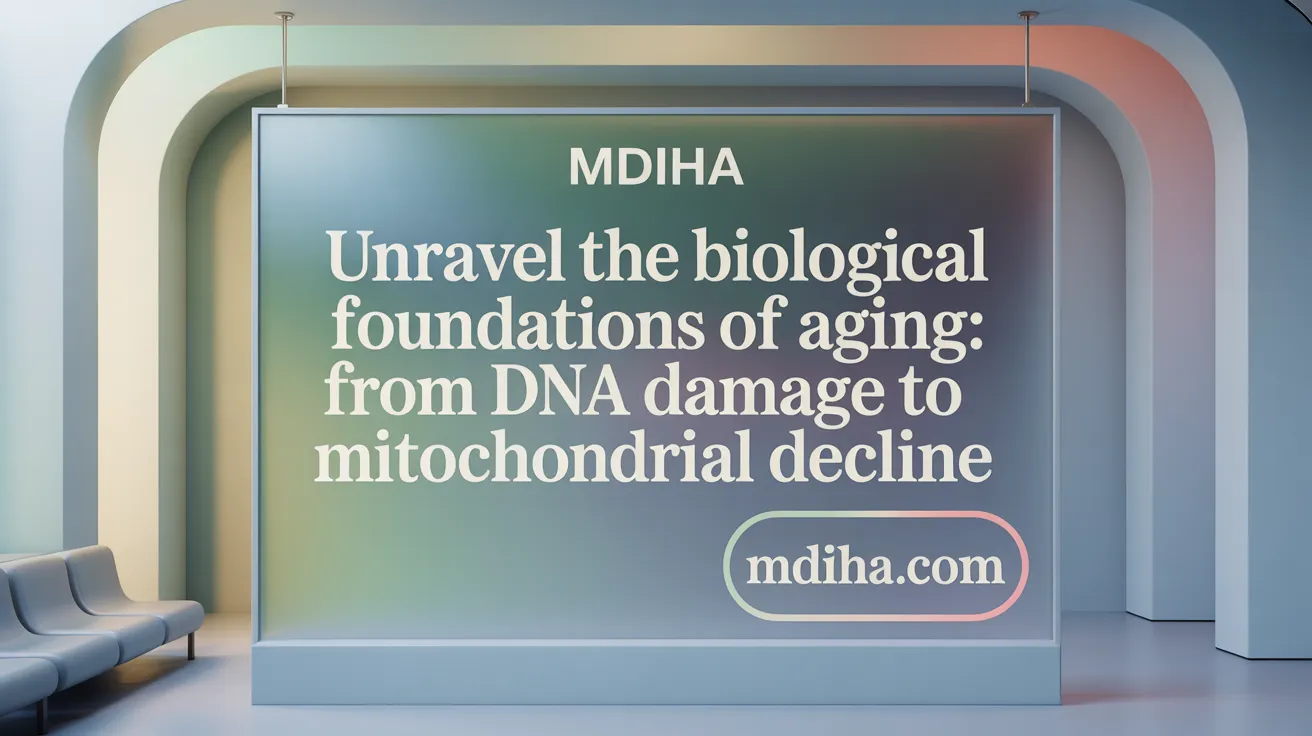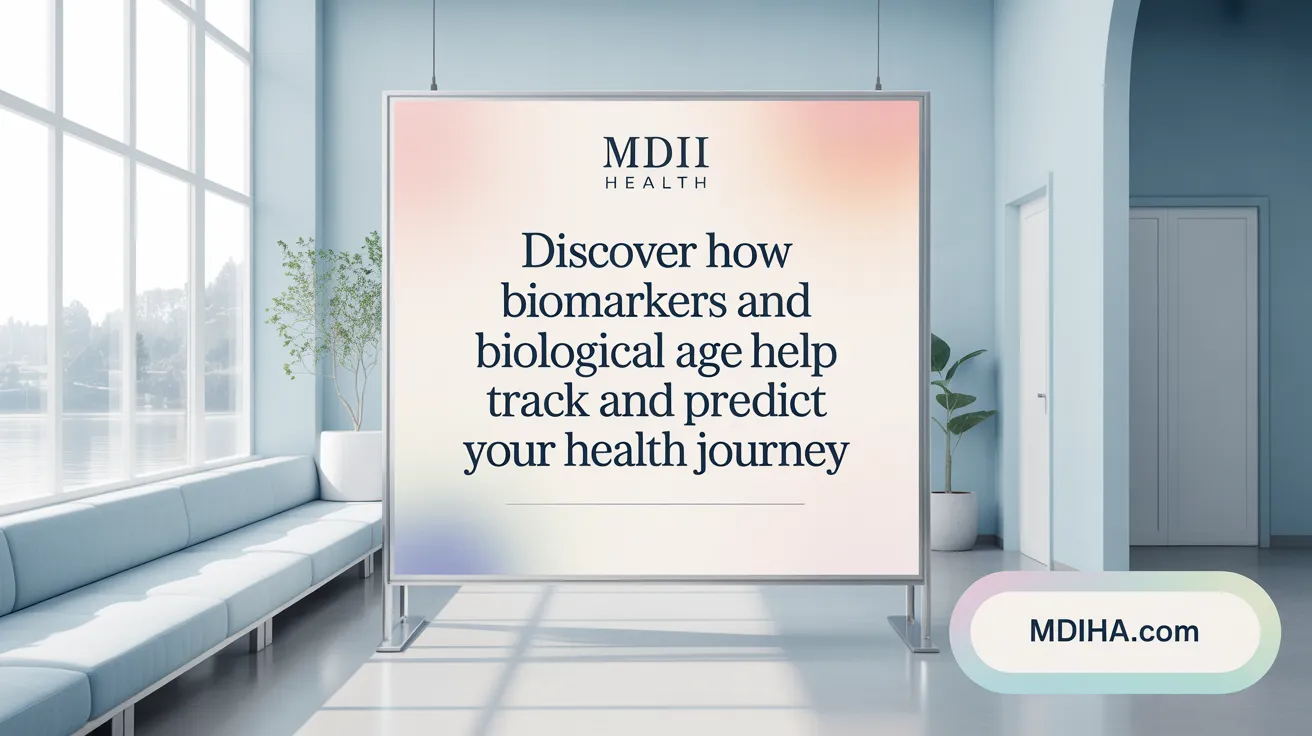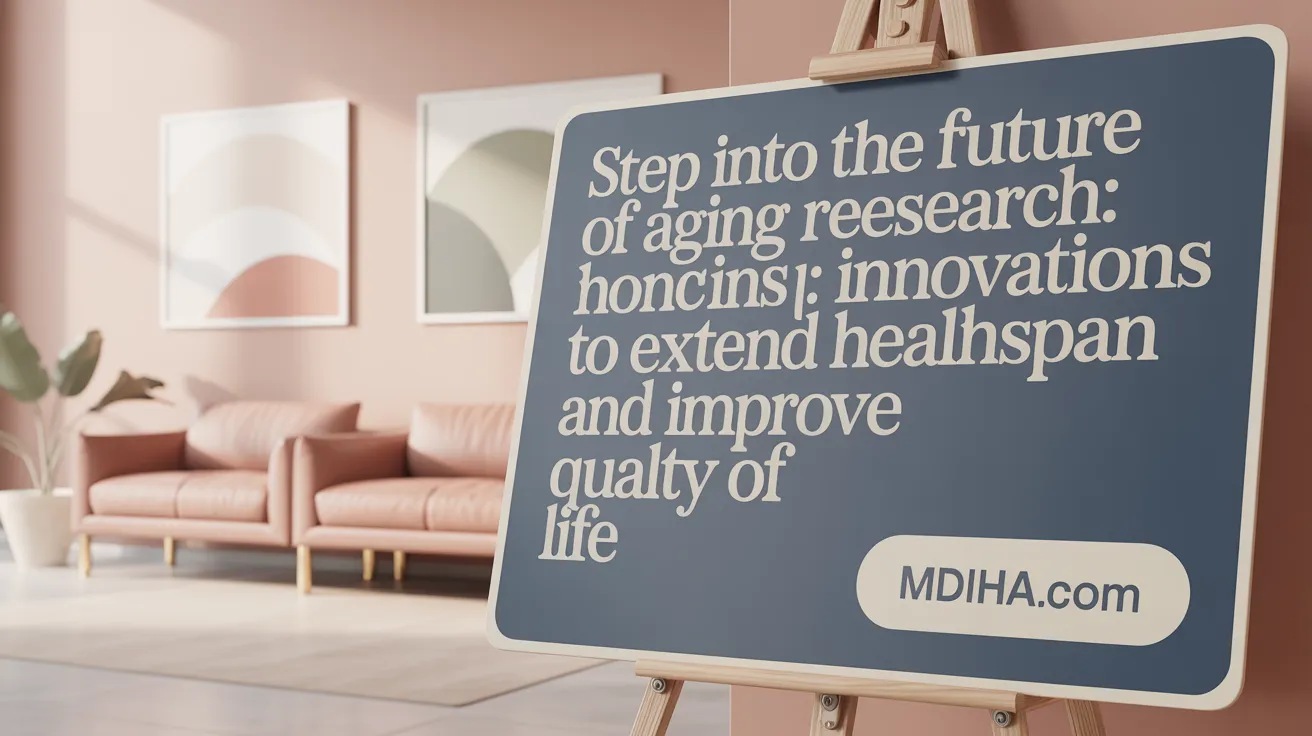Understanding the Science Behind Healthy Aging
Aging is a multifaceted biological process intertwined with genetics, lifestyle, and environmental influences. Amidst rising interest in prolonging healthspan rather than just lifespan, the emerging discipline of Valengerontology offers a comprehensive lens on healthy aging by integrating scientific advances with personalized, data-driven strategies. This article explores the foundational biological mechanisms underpinning aging, the role of biomarkers, the significance of super-agers, and the latest innovations propelling the field toward unlocking secrets to healthy longevity.
Molecular Mechanisms and Biological Foundations of Aging

What are the scientific principles and mechanisms underlying aging and healthy aging?
Aging results from intricate biological processes that cause gradual decline in tissue and organ function over time. It is driven by multiple interconnected mechanisms, including accumulation of DNA damage, shortening of telomeres, and widespread epigenetic modifications. These changes impair cellular health, reduce the body's ability to repair and maintain itself, and increase susceptibility to age-related diseases. For detailed information, see hallmarks of aging and Molecular mechanisms of aging.
Core pathways such as nutrient sensing and mitochondrial health play pivotal roles. Disruptions in mTOR and insulin/IGF-1 signaling pathways affect how cells grow, repair, and adapt to stress, impacting overall longevity. Maintaining genomic stability through efficient DNA repair, proper chromatin regulation, and proteostasis—the balance of protein synthesis, folding, and degradation—are essential for healthy aging. Learn more about biology of aging and aging and aging-related diseases.
Lifestyle factors like caloric restriction, physical activity, and emerging therapeutics targeting senescence and autophagy further support these biological foundations. Overall, healthy aging depends on preserving cellular resilience and systemic homeostasis in the face of molecular damage and functional decline. For evidence-based healthy aging strategies and emerging therapies, refer to Can We Slow Aging? and Science-based tips for healthy aging.
Biological Age, Biomarkers, and Their Role in Assessing Aging Dynamics

What are biomarkers and biological age indicators, and how are they used to assess aging?
Biomarkers are measurable signs or indicators that reflect biological processes occurring within the body. In the context of aging, they serve as vital tools to understand the physiological state and health trajectory of an individual. They include molecular markers like DNA methylation patterns, telomere length, levels of inflammatory proteins, and cellular health markers (biology of aging, hallmarks of aging).
Biological age indicators specifically estimate how old a person's body truly is, which may differ from their chronological age. These indicators rely on assessing a combination of molecular, cellular, physiological, and imaging-based data to gauge the aging process more accurately. For example, DNA methylation clocks—also called epigenetic clocks—use specific DNA methylation patterns to provide an estimate of biological age. These patterns change predictably with age and are sensitive to lifestyle, environment, and health status (DNA methylation and aging, aging clocks).
Using these biomarkers, scientists and clinicians can predict health outcomes such as risk of age-related diseases, mortality, and the effectiveness of interventions. They are incorporated into algorithms, often utilizing machine learning techniques, to provide a comprehensive aging profile (Stanford Medicine Center for Longevity and Healthy Aging). Such assessments are crucial in research, where they help evaluate how different lifestyle changes, drugs, or therapies influence the aging process.
Despite their promise, challenges remain in standardizing and validating biomarkers for routine clinical use. Variability across populations and measurement techniques can affect reliability. The goal is to develop minimally invasive, accurate, and scalable biomarkers that can reliably predict health outcomes and guide personalized aging interventions (Medical Institute of Healthy Aging).
In summary, biomarkers and biological age indicators are central to advancing our understanding of aging. They enable more precise assessments of individual health trajectories and help tailor strategies aimed at extending healthspan and improving quality of life during aging (Healthy Aging Research, SuperAgers research).
The Emergence of Valengerontology and Its Role in Healthy Aging Medicine

Introduction to Valengerontology
Valengerontology, also known as Healthy Aging Medicine, is an innovative medical specialty dedicated to optimizing longevity and wellness through personalized, scientific methods. This field is centered around understanding and managing the biological and physiological processes that influence aging, aiming to extend healthspan—the period of life spent in good health (Healthy Aging).
Personalized, Data-Driven Approaches to Aging
At the core of valengerontology is a data-driven approach. Medical institutes like the Medical Institute of Healthy Aging utilize advanced diagnostics, including biomarkers that measure biological age, hormonal balance, and inflammatory markers. This detailed profiling helps tailor individual interventions that may slow down aging or mitigate age-associated diseases (Biology of Aging).
Diagnostic Biomarkers Utilized
A variety of biomarkers are employed in valengerontology. These include blood-based indicators like NAD+ levels, telomere length, and DNA methylation patterns—also known as epigenetic clocks (Molecular mechanisms of aging). Imaging and lab panels support early detection of health risks, enabling preemptive treatments to preserve vitality (Slowing Aging).
Therapeutic Options Including Peptides, Stem Cells, IV Treatments
Therapies in valengerontology are diverse. They encompass peptides to regulate growth and repair, stem cell therapies to promote tissue regeneration, and intravenous nutrient treatments that deliver vital compounds directly into the bloodstream. These interventions aim to rejuvenate tissues and improve overall function (Medical Institute of Healthy Aging).
Hormonal and Inflammatory Marker Assessments
Assessing hormonal and inflammatory markers provides insights into systemic aging processes. Imbalances in hormones like testosterone, estrogen, and growth hormone are corrected to support metabolic health. Reducing chronic inflammation—linked to many age-related conditions—is a primary focus, often addressed through lifestyle and pharmaceutical strategies (Medical Institute of Healthy Aging).
Virtual Health Programs for Longevity and Wellness
Accessibility is enhanced through virtual programs, offering hormone balancing, weight management, and longevity protocols remotely. This flexibility allows individuals worldwide to benefit from personalized aging interventions without geographical barriers (Medical Institute of Healthy Aging).
Relation to Geroscience and Healthy Aging
Valengerontology aligns closely with geroscience, which investigates the biological basis of aging to develop interventions that delay or prevent multiple age-related diseases simultaneously. Both fields share the goal of extending healthspan through understanding molecular, cellular, and systemic aging pathways (Healthy Aging).
Growing Recognition and Protocols in Aging Medicine
Recognized as a distinct discipline, valengerontology is gaining attention in mainstream healthcare. Protocols involving innovative testing like EBOO (extracorporeal blood oxygenation and ozone therapy) and technologies like TruDiagnostic are advancing personalized aging medicine. Experts like Dr. Paul H. Kim are leading this frontier, emphasizing prevention and science-based treatments.
Understanding this emerging field provides a promising outlook for how aging might be managed more effectively, emphasizing health, vitality, and quality of life well into older age (Unlocking the Secrets of Super-Agers).
Decoding Super-Agers: Insights into Exceptional Longevity and Cognitive Resilience

Who are super-agers and what factors contribute to exceptional longevity?
Super-agers are a remarkable group of adults aged 80 or older who retain memory and cognitive abilities that are typically seen in much younger adults. They often exhibit biological features that set them apart from their peers, such as larger brain volumes, especially in regions linked to memory and movement, and a slower rate of brain shrinkage over time (Super-agers and memory capacity).
Research shows that genetics play a role; for example, many super-agers have a family history of longevity or possess genetic traits like the presence of von Economo neurons, which are associated with advanced social and emotional processing. Their brains display less accumulation of harmful proteins like amyloid and tau, common in neurodegenerative diseases. Additionally, they tend to have a thicker cortex, which correlates with better cognitive function (SuperAgers research, Genetics and healthy aging, DNA damage and aging).
Lifestyle choices are equally significant. Super-agers often engage in regular physical exercise, such as challenging activities like gardening or stair climbing, which promote brain plasticity through new cell growth and improved blood vessel health. Mental stimulation, including reading, puzzles, and learning new skills, helps build cognitive reserve—the brain’s ability to withstand damage. Strong social networks and participation in community or family activities contribute further to mental resilience (Physical exercise and brain health, Mental activities for cognitive fitness, Social connections and dementia risk).
Dietary habits also matter; many follow the Mediterranean-DASH diet, consuming nutrient-rich foods that support brain health. Good sleep, typically between 7-9 hours, is crucial as it helps clear waste products linked to Alzheimer’s disease and enhances memory consolidation (Adequate sleep for brain waste clearance, Healthy Aging: What We Know).
While biological and genetic factors provide a foundation, lifestyle choices significantly influence the longevity and cognitive trajectory of super-agers. Ongoing research aims to better understand these elements and uncover strategies to replicate their healthspan benefits across broader populations (Healthy aging choices, Healthy Aging Research open access journal).
Innovations and Advances in Geroscience and Aging Research
 Recent progress in aging science reflects a dynamic integration of biological insights, innovative technologies, and multidisciplinary collaboration. One major development is the advancing understanding of the cellular and molecular hallmarks of aging, which include DNA damage, mitochondrial decline, cellular senescence, and epigenetic changes. These discoveries underpin novel therapeutic strategies, especially senolytic agents designed to remove senescent cells that contribute to tissue dysfunction and chronic inflammation.
Recent progress in aging science reflects a dynamic integration of biological insights, innovative technologies, and multidisciplinary collaboration. One major development is the advancing understanding of the cellular and molecular hallmarks of aging, which include DNA damage, mitochondrial decline, cellular senescence, and epigenetic changes. These discoveries underpin novel therapeutic strategies, especially senolytic agents designed to remove senescent cells that contribute to tissue dysfunction and chronic inflammation.
A promising area is mitochondrial-targeted therapies, aimed at restoring mitochondrial function and reducing oxidative stress. These approaches seek to improve cellular energy production and slow down age-related deterioration. Simultaneously, the field is leveraging machine learning and artificial intelligence to parse vast datasets for biomarker discovery, predict individual aging trajectories, and personalize interventions. Initiatives like DNA methylation clocks are increasingly being used in clinical trials to quantify biological age and evaluate the effects of treatments (biology of aging, Stanford Medicine Center for Longevity and Healthy Aging).
Current clinical trials are testing various gerotherapeutics, including drugs like metformin and novel compounds aimed at modulating nutrient-sensing pathways such as mTOR. These studies also focus on validating new biomarkers for earlier detection and better monitoring of aging processes. Regulatory bodies and researchers are working together to establish frameworks for classifying and approving anti-aging strategies, which remains a challenge but is vital for clinical translation (hallmarks of aging, Can we slow aging?).
Technological advancements are also revolutionizing experimental models. Bioengineering tools like organoids and organs-on-a-chip recreate human tissues and organ systems in vitro, allowing for detailed studies of aging mechanisms and therapeutic testing in controlled environments. Space research, particularly experiments conducted aboard the International Space Station (ISS), exposes biological systems to microgravity and radiation, providing unique insights into accelerated aging phenomena.
Complementing these scientific approaches are digital health innovations. Wearable sensors and remote monitoring devices enable continuous health tracking, while virtual reality and robotics support mobility, cognitive training, and social engagement in older adults. These tools enhance personalized care, foster independence, and reduce healthcare burdens (Stanford Medicine Center for Longevity and Healthy Aging).
Overall, the convergence of molecular biology, bioengineering, space science, and digital technology is propelling aging research into a new era. These advances aim to extend healthspan, improve quality of life, and ultimately transform aging from an inevitable decline into a manageable and even reversible process (more evidence that aging might be reversible). Challenges persist in regulatory approval, funding, and broad implementation, but the trajectory of research promises a future where aging is no longer an unalterable fate.
Lifestyle, Prevention, and Ethical Considerations in Promoting Healthy Aging
What is the scientific basis for preventative health, lifestyle modifications, and health management strategies to promote healthy aging?
The foundation of preventative health strategies in aging is built on extensive scientific research demonstrating that certain behaviors and interventions can influence the biological processes associated with aging. Regular physical activity, such as walking, gardening, or resistance training, has been shown to improve cardiovascular health, maintain muscle mass, and reduce risks of chronic diseases. A nutritious diet, especially one following the Mediterranean pattern rich in fruits, vegetables, whole grains, and healthy fats, helps lower inflammation and oxidative stress.
Adequate sleep (7-9 hours) enables proper memory consolidation and waste clearance from the brain, reducing risks of neurodegenerative diseases. Quitting smoking at any age significantly improves health outlooks, lowering the incidence of cancers and cardiovascular diseases, while moderate alcohol consumption has protective effects, provided it does not lead to excessive intake. These facts are supported by research on healthy aging habits.
Furthermore, early disease screening, social engagement, and mental stimulation support emotional well-being and cognition. Advances in geroscience research highlight molecular targets such as cellular senescence and mitochondrial dysfunction. Interventions like caloric restriction, metformin, and emerging pharmacological agents aim to delay the aging process itself as described in detailed biological mechanisms of aging.
Altogether, these strategies are supported by robust evidence indicating that lifestyle modifications can extend both lifespan and healthspan, enabling older adults to enjoy better quality of life, consistent with guidelines from healthy aging resources.
What ethical and practical implications arise from aging research and potential anti-aging strategies?
Aging research offers promising avenues to extend health and longevity, yet it also raises vital ethical and practical concerns. Equity issues are paramount; access to novel therapies like gene editing, stem cell treatments, or pharmacological interventions may be limited by socioeconomic status, risking increased societal disparities.
Societally, extending lifespan could impact resource distribution, healthcare systems, and environmental sustainability—raising questions about overpopulation and allocation of medical resources. The debate on classifying aging as a disease influences regulatory policies but also sparks ethical issues about medicalization and resource priorities.
The safety and long-term effects of anti-aging therapies, including gene editing and AI-based personalized treatments, remain under scrutiny. There is a need for rigorous clinical trials, oversight, and guidelines to ensure these technologies are both safe and equitable, as highlighted by aging research at leading academic centers.
Responsibly deploying anti-aging strategies involves balancing innovation with ethical considerations, ensuring benefits are accessible to all, and avoiding misuse or unintended societal consequences.
More Information Search Query
The search query
Bridging Science and Practice for a Future of Healthy Longevity
The evolving science of Valengerontology demonstrates that aging is not merely an inevitable decline but a complex, modifiable process influenced by molecular mechanisms, genetics, lifestyle, and environment. Through cutting-edge research integrating biological insights, biomarker technologies, and personalized medicine, it is increasingly possible to tailor interventions that promote resilience, cognitive health, and extended healthspan. Super-agers exemplify the potential of harmonious genetic and behavioral factors in achieving exceptional longevity. Meanwhile, technological advances and ethical frameworks guide the responsible development and equitable distribution of anti-aging strategies. As these multidisciplinary efforts continue, knowledge dissemination and early, personalized prevention remain essential. The future holds promise for transforming aging from a challenge into an opportunity to live longer, healthier, and more fulfilling lives.
